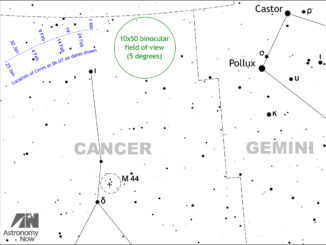
Messier 44 in Cancer, very well known under its popular alias the Beehive Cluster and less commonly Praesepe (Latin for crib or manger), has few rivals as an open star cluster in the entire sky. Shining with an integrated magnitude of +3.1, from the combined light from its hundreds of stars that are confirmed Beehive members, makes the Beehive brighter than any of the stars within Cancer’s boundaries.
M44 been known since antiquity; Hipparchus included it in his catalogue and called it ‘Little Cloud’ or ‘Cloudy Star’. Galileo was the first to resolve stars within the cluster, in 1609 and Sir John Herschel christened it the ‘Beehive’
A pair of binoculars will snare the Beehive without difficulty under a moderately light-polluted sky and it’s easy to see with the naked eye as a fuzzy smudge from a dark-sky site. The Beehive is also very easy to locate, lying just about slap-bang at the centre of Cancer, the Crab. Add all this up and we’ve got one of the finest deep-sky objects of the late-winter sky that demands to be observed.

Track it down
The Beehive (NGC 2632) lies between the stars Asellus Borealis (gamma [γ] Cancri, magnitude +4.7) and Asellus Australis (delta [δ] Cancri, +3.9), which lie to the north-north-east and south-east, respectively. At mid-month, M44 is well up in the east when skies become astronomically dark and culminates at about 11pm at an altitude of between 53° and 59°, depending where in the UK you’re observing from. Night owls can follow it well into the small hours.
The Beehive Cluster is one of the largest open clusters; in fact its apparent diameter of 95’ is around three times that of a full Moon! A pair of 10 x 50 binoculars reveal around 50 stars buzzing around a central asterism shaped like a miniature Hercules ‘Keystone’, while a small telescope operating at low powers will show many more and bring out the yellow-orange hue of some of its brighter stars.
Messier 44 lies about 610 light years away and has a physical diameter of around 15 light years. It’s quite a young cluster, believed to have formed some 600 million years ago.





